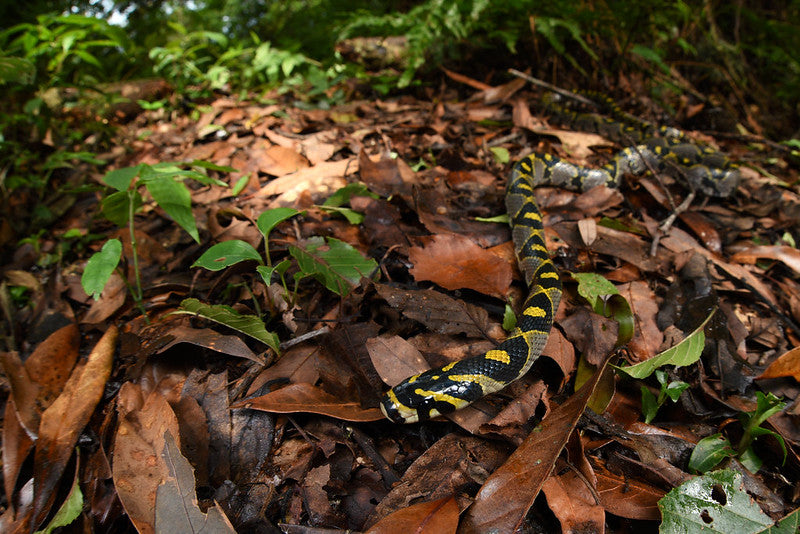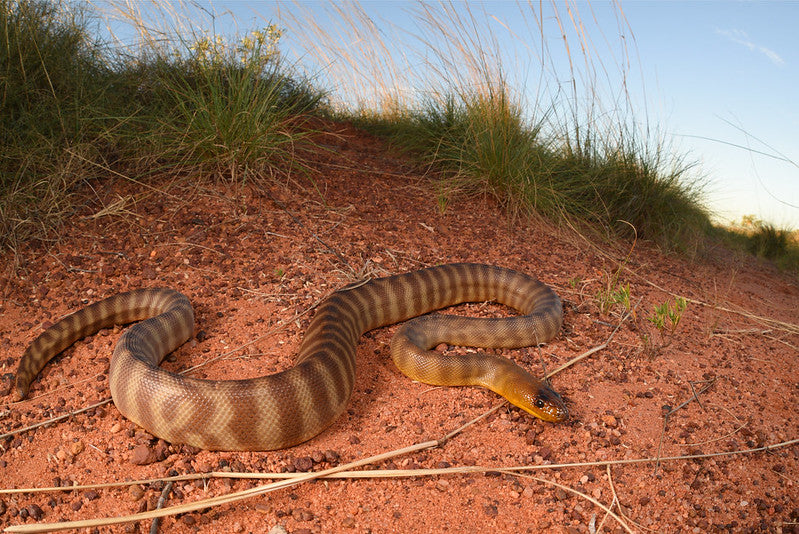Mandarin rat snakes (Euprepiophis mandarinus) are small to medium-sized, terrestrial, crepuscular snakes native to the southeastern quarter of the Asian continent: India, Myanmar, Laos, Vietnam, Taiwan, and China. Their preferred habitat ranges from high-elevation montane forest to bush-covered rocky slopes, although they are also found in farmland and fields, as well as occasionally at lower elevations.
Mandarin rat snakes are around 4’ long, although they are known to occasionally grow up to 6’ long. They have a slender body, oval head, blunt snout, black eyes, and smooth, glossy scales. Exact coloring and pattern varies, but generally speaking, mandarin rat snakes have a gray, brown, or reddish base color with black diamond-shaped blotches down the length of their body, each outlined with yellow and containing a yellow spot. The head is marked by broad black bands.
Mandarin rat snakes are secretive animals that make intermediate-level pets due to their low tolerance for handling and high humidity needs. Average lifespan with good care is at least 10-15 years.
How much space do mandarin rat snakes need?
Like ball pythons, mandarin rat snakes are popular for keeping in undersized tub-style enclosures due to their reclusive nature. However, this species still needs an enclosure that allows them to stretch out fully, thermoregulate, and explore as desired.
The minimum for appropriately keeping one mandarin rat snakes is 48”L x 24”W x 24”H, but larger can also be provided, especially for longer individuals. For the snake’s comfort (and reduced risk of escape), this enclosure should be front-opening and have opaque sides — like our Reptile Habitats 4x2x2 (120 Gallon) Reptile Enclosure!
Cohabitation (keeping multiple mandarin rat snakes in one enclosure) is not recommended, as they may fight and injure one another.
Do mandarin rat snakes need UVB?
While mandarin rat snakes are capable of surviving without access to UVB, it’s still best practice to provide low-intensity UVB lighting for optimal health and wellbeing. UVB gives reptiles all of the vitamin D that their bodies need, stimulates better appetite and activity, and generally allows them to be healthier than they would be without.
Here are the best UVB bulbs for mandarin rat snakes:
- Zoo Med Reptisun T5 HO 5.0, 22”
- Arcadia Forest 6%, 22”
The UVB bulb should be housed in a reflective fixture such as Arcadia or Vivarium Electronics, and placed close to the heat lamp, about 11-13” above the snake’s back if over mesh, and 14-16” above the snake’s back if not. Make sure that the fixture your UVB bulb is in does not have a clear plastic or glass bulb cover, as these materials block UVB. UVB lighting also decays over time, so make sure to replace your bulb every 12 months to maintain its performance.
Mandarin rat snakes should receive 13 hours of light per day during summer, and 11 hours per day during winter. This helps create a more natural hormonal cycle for them.
What basking temperatures do mandarin rat snakes need?
Like other reptiles, mandarin rat snakes are ectotherms, which means that they need a temperature gradient in their enclosure to help them regulate their metabolism and stay healthy.
That being said, mandarin rat snakes prefer to stay cooler than most snakes:
It is very important that this species has ready access to a cool area in the enclosure, or else they will get stressed and potentially die! Keep track of your temperatures with digital probe thermometers, one probe on the basking surface and another probe on the cool side.
Provide heat for your snake by imitating the sun with one or two moderate-wattage heat bulbs clustered on one side of the enclosure. This should create an area of gentle heat large enough to evenly heat the snake’s entire body when coiled. Do not use colored bulbs, as these are not as effective. If temps get too high, dim the bulbs with a plug-in lamp dimmer or rheostat. If temps are too low, you need higher-wattage bulbs.
Alternatively, you can use a small heat mat sandwiched between a plastic box hide (bottom) and a piece of flat stone (top). This should be plugged into a thermostat set to 82-85°F to prevent it from getting dangerously hot. The thermostat probe should be placed inside the warm hide.
Heating should be turned off at night so temperatures can drop.
What humidity levels do mandarin rat snakes need?
Mandarin rat snakes need an environment that is humid and fairly damp, but not soggy. Provide daytime humidity levels between 50-70%, and nighttime humidity levels higher.
Measure the humidity in your snake’s enclosure with a digital probe hygrometer placed in the middle of the enclosure. It’s also good practice to provide a humid hide for your snake on the cool side of the enclosure, lined with moistened sphagnum moss.
Misting your snake’s enclosure with a sprayer first thing in the morning and again at night will help create the right humidity levels. If you need more, using a cool-mist reptile humidifier at night, connected to a timer or hygrostat, is also helpful.
What substrate is good for mandarin rat snakes?
Mandarin rat snakes require a thick (>4”) layer of moisture-retentive substrate to accommodate their natural burrowing tendencies and help maintain healthy humidity levels. As an added perk, it also tends to make the enclosure more attractive!
We recommend the following substrates for mandarin rat snakes:
- Zoo Med Eco Earth
- Zoo Med ReptiSoil
- Exo Terra Plantation Soil
- Zilla Jungle Mix
- Galapagos Terrarium Sphagnum Moss
Adding a thick layer of clean, chemical-free leaf litter on top of the substrate can also help with humidity and provides additional cover to help your snake feel secure in its environment.
Substrate should be completely replaced every 2-3 months. Remove poop and urates immediately, along with contaminated substrate, to maintain hygiene and make your substrate last.
What décor can you use in a mandarin rat snake terrarium?
It’s terribly boring (and even stressful) for a snake to be stuck in an enclosure with nothing in it. It doesn’t matter how big the enclosure is if you don’t put things in it for your pet to use and interact with!
Aside from substrate and a big water bowl, here are some other things to include in your mandarin rat snake’s setup:
- hides/caves
- sturdy low branches
- cork tubes/flats
- live tropical plants
- artificial plants
Hiding places are an absolute necessity for keeping a mandarin rat snake happy. Make sure to use your décor items to provide plenty of cover, and you’re more likely to see your snake out and about more often!
What do mandarin rat snakes eat?
Like other snakes, mandarin rat snakes are carnivores, which means that they need to eat whole animal prey in order to get the nutrition that they need. Here is a basic feeding schedule based on snake age:
- Juveniles should be fed once every 4-6 days.
- Adults should be fed once every 7 days.
Prey items should be between 5-10% of your snake’s weight and/or roughly the same width as its body. When in doubt, mandarin rat snakes prefer multiple small prey over one big prey item. Although live prey can be used, it’s safest and most humane to use frozen instead. Prey should be thawed in a plastic bag in warm water before offering with a pair of soft-tipped tweezers.
Mandarin rat snakes can be shy feeders, so if your pet doesn’t accept food from the tongs, try putting it on a plate, cover it with a paper towel, and leave it in the enclosure overnight. Aside from being shy, this species also likes to uncover their own food from a hidden location.
Remember, the key to great nutrition is variety! Aside from offering young mice and rats, chicks, quail, feeder anoles, and feeder geckos can also be used to create nutritional variety in your snake’s diet. Juveniles in particular are likely to favor lizard prey.
Supplements
Mandarin rat snakes can survive without vitamin or mineral supplements, but occasionally using them can help prevent nutritional deficiencies and optimize your snake’s health. We recommend Repashy Calcium Plus LoD.
Water
Your mandarin rat snake should have access to clean, fresh water at all times. The water bowl doesn’t need to be big enough for soaking, but it does need to be heavy enough to resist tipping. Change the water daily and scrub the bowl with a reptile-safe disinfectant weekly, or whenever it becomes soiled.
Do mandarin rat snakes like to be handled?
Few reptiles actually “like” to be held, and mandarin rat snakes largely prefer to be left alone. They’re nervous animals and get stressed easily with too much meddling, especially as juveniles. Biting and/or musking is a possibility when the snake is stressed.
If you need to pick up your snake, wear a pair of gloves, be gentle, and let the snake cruise from one hand to the other. This species is not particularly proficient at climbing, so make sure to support their body well during handling, as they’re not going to hold onto you. NEVER pick up a snake by its tail!
*This care sheet contains only very basic information. Although it’s a good introduction, please do further research with high-quality sources to obtain additional information on caring for this species.
"高砂蛇(Euprepiophis mandarinus)" by Wild for Wildlife is licensed under CC BY-NC-SA 2.0.




Leave a comment
This site is protected by hCaptcha and the hCaptcha Privacy Policy and Terms of Service apply.